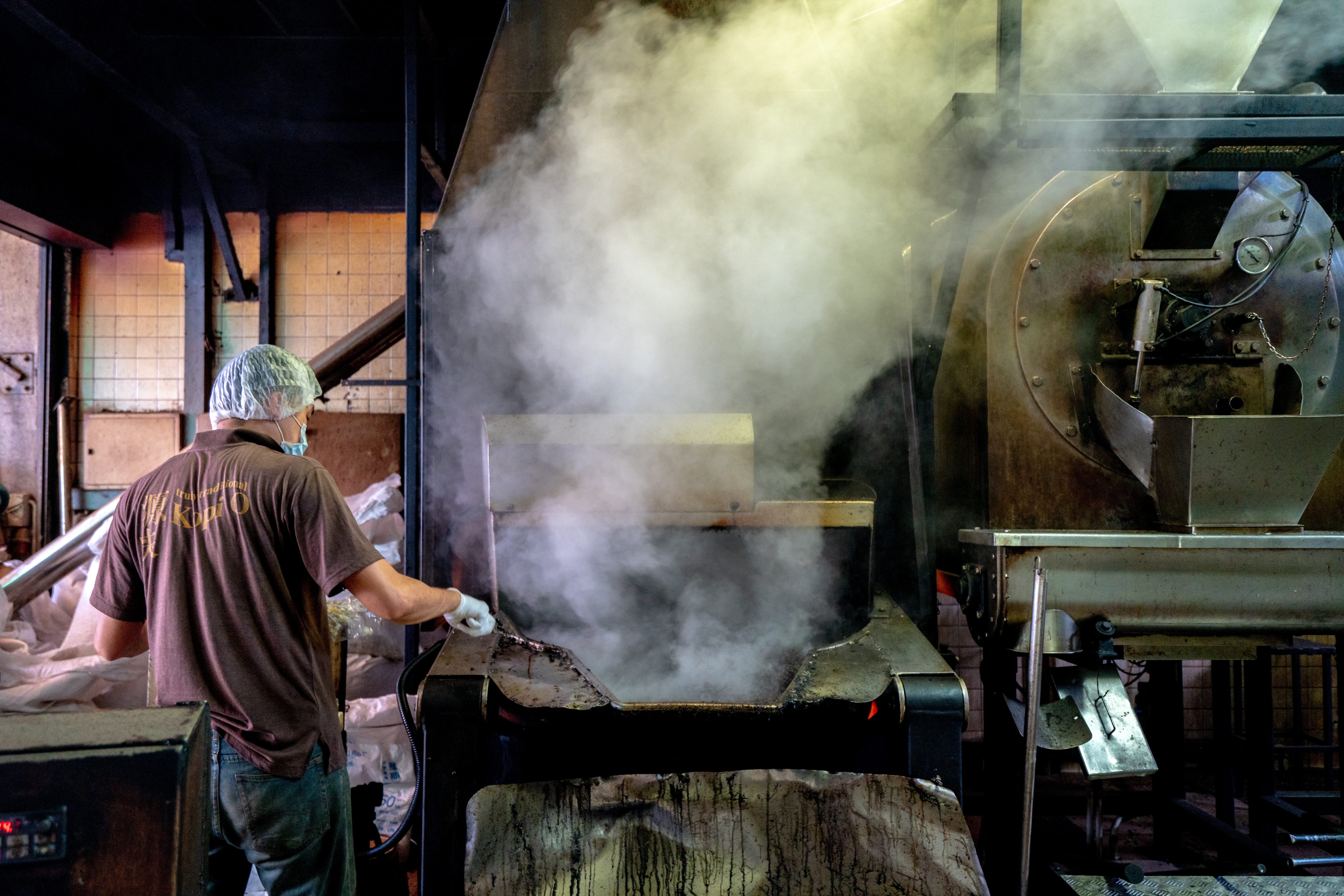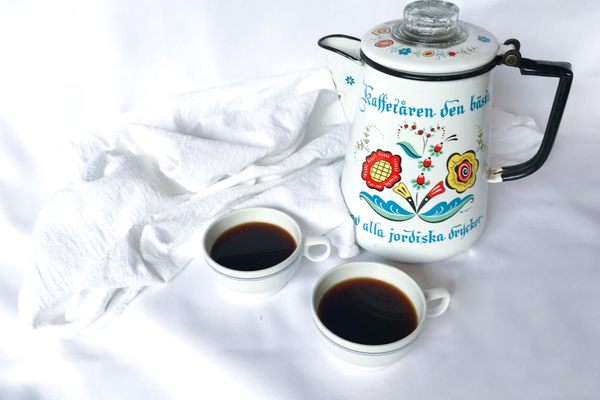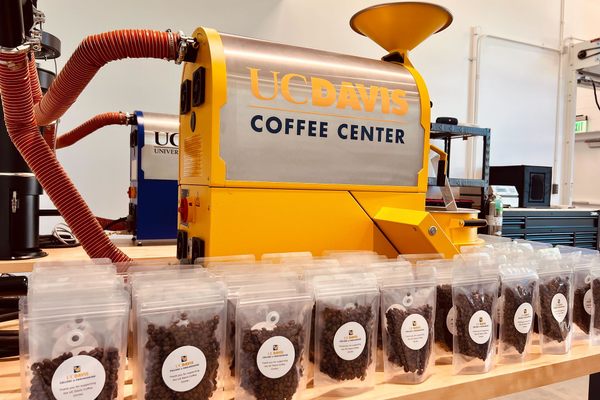Singapore’s Last Traditional Coffee Roasters May Soon Disappear
The aging masters of kopi are desperate for the next generation to take up their craft.
Inside an aging industrial park, a nutty, sweet aroma wafts through the air. Smoke billows out of one particular shophouse in a row of red-brick, one-story factories.
Inside, four men clad in polo shirts, hair nets, masks, and heavy-duty gloves emerge from the smoke. With metal rods, they repeatedly slam a mound of caramelized coffee beans inside a tub, breaking them apart. These are employees of Kim Guan Guan, one of the last traditional coffee roasters in Singapore.
Jason Soon founded Kim Guan Guan in 1988. Initially, he saw coffee as only a business opportunity. For years, all he did was import and sell raw coffee beans. But soon, coffee grew into his passion. In 1996, Soon bought a coffee roasting factory and learned how to make kopi, a style of coffee unique to Southeast Asia.
When robusta beans are cooked with copious amounts of sugar and margarine, then ground and brewed, the result is a distinctively thick, luscious cup of coffee. Often, the coffee is made using a flannel sock as a filter, and poured into ceramic or glass cups from long-sprouted kettles to create a frothy, smooth brew. It can be drunk black, or with sugar and evaporated milk.

However, kopi is commonly considered low-grade compared to gourmet brews. Roasters blame this on the price. One cup of kopi costs less than S$2 ($1.49 USD) and is usually purchased at the hot, open-air food courts called kopitiams. An Americano, in contrast, sells for at least twice as much at chic cafes.
Yet kopi has a rich history. According to Soon, this roast dates back to the 19th century. European settlers in colonial Singapore had a habit of drinking coffee. They imported arabica beans, which merchants coated with sugar to preserve it during shipping. When locals picked up the habit as well, many could only afford the cheaper robusta beans grown in Indonesia.
To mimic the flavor of the more-expensive arabica, they cooked the beans with butter or margarine, as well as sugar. Robusta beans have around twice the amount of caffeine as arabica, more bitterness, and less acidity. As a result, kopi, which means “coffee” in Malay, became the regional favorite for its caffeine content, sweetness, and cheapness.

In Soon’s factory, one batch of coffee takes 45 minutes to roast. In the first 35 minutes, the beans are cooked at around 240°C (464°F). Keen-eared roasters must listen to a certain sequence of crackling that signals doneness. Next, the beans are poured into a wok of caramel that emits a cloud of thick white vapor as moisture from the melted sugar evaporates. The roaster tosses the blend to make sure all the beans are thoroughly coated, and adds a healthy helping of margarine. For every 60 kilograms (132 pounds) of beans, Kim Guan Guan uses 18 kilograms of sugar (40 pounds) and 1.7 kilograms (3.7 pounds) of margarine.
Once ready, the beans are poured into a metal tub and the workers quickly separate the smoking beans before the sugar crystallizes. Once the beans are cooled, the roasters store them in gunny sacks before grinding them and shipping the coffee off to customers.
Kim Guan Guan produces 2.5 tons of coffee a day, and clients include local coffee chains, grocers, and hawker stalls. Soon, 54, says he exclusively roasts kopi for two reasons. One, he doesn’t want his palate to be affected by other brews. Secondly, he sees a mission in sustaining the dying art of kopi roasting. “If us manufacturers don’t work hard at preserving it, who will?” he asks. “This is part of Singapore’s heritage.”

Kopi is integral to Singapore’s culture because of its ubiquity, says Nicole Tarulevicz, a history professor at the University of Tasmania who studies the country’s culinary heritage. Kopitiams are everywhere across the island, so people can grab their cup of joe anytime they want.
Drinking kopi lets tourists feel like they are getting the authentic Singaporean experience and helps residents connect to their country. “It’s a way of saying that we’re really Singaporeans,” Tarulevicz says. “In a place where there’s been a lot of change…I think it is quite comforting.”
Coffee is still the hottest drink in Singapore, but even that faced change after the third-wave coffee movement arrived in the late 2000s. These days, few people in Singapore want to enter a trade this labor-intensive, Soon says, with its long hours in a hot and smoky room. Young people prefer to work with high-end arabica beans roasted in clean, air-conditioned rooms: no butter or caramel in sight.
Jimmy Ng, the owner of Fresh Roaster, has difficulty finding workers. Out of his nine roasters, only two are Singaporeans and the rest are foreigners. Ng also started out as a coffee distributor in 1979, before setting up his own factory in 1997. Both he and Soon reckon there are only around 10 local kopi roasters left today, down from the 20 that existed when they started their businesses, and far from the heyday of the 1960s when hawkers roasted their own coffee in alleyway stalls.

While coffee roasters in Singapore itself are getting rarer, kopi’s global footprint is expanding every day. Kopi is now available worldwide through Singaporean coffee chains such as Ya Kun Kaya Toast and Killiney Kopitiam, which have opened stores from Palo Alto to Tokyo.
But in Singapore, a lack of properly roasted beans looms on the horizon. Small local kopitiams will have to look for new suppliers if the traditional ones close down, or perhaps import their roasted coffee from Malaysia, where kopi is also a standard.
But there are younger Singaporeans trying to keep the kopi-roasting tradition alive. Faye Sai is the third-generation owner of Coffee Break. In 2014, she and two siblings took over their family kopitiam when their father retired. “We definitely don’t see young people doing it [and] realized that this trade is quite precious,” the 34-year-old says.
Ever since they took over the business, the siblings have expanded the menu to include modern flavors with their traditionally roasted kopi, such as sea salt caramel and matcha, to great success.

Guan Lim, head of the Queen’s Coffee roastery and a member of the Singapore Coffee Association, has another solution to the kopi dilemma: raising the price of a cup. “Profit margins are nearly zero. We need to make this trade more lucrative, otherwise there’s no way we can hold on,” he says.
No matter what, Soon and Ng are certain that kopi will always be in demand locally. What they are less sure about is its quality. It is likely that more businesses will roast or buy their coffee from abroad as more Singaporean roasters close down. “It will no longer be authentic if kopi is manufactured overseas,” says Soon.
At the moment, the future of both Soon and Ng’s roasters are precarious. Soon is unsure whether his children will take over the business. Ng, who is 63, says he hopes to find a buyer before he retires. “If I can’t sell the business, then I have no choice. It will close for good,” he says.
Gastro Obscura covers the world’s most wondrous food and drink.
Sign up for our regular newsletter.



























Follow us on Twitter to get the latest on the world's hidden wonders.
Like us on Facebook to get the latest on the world's hidden wonders.
Follow us on Twitter Like us on Facebook